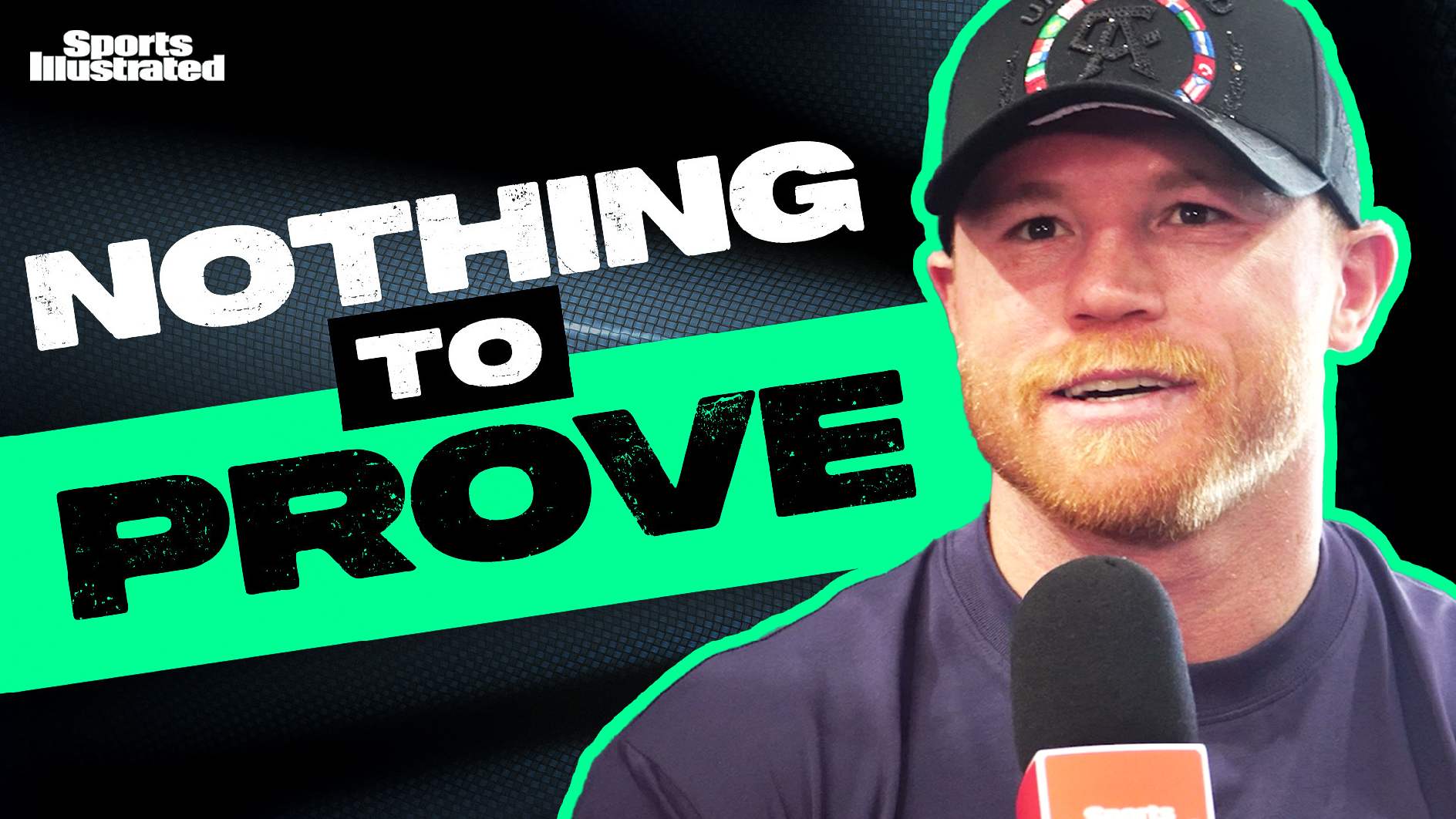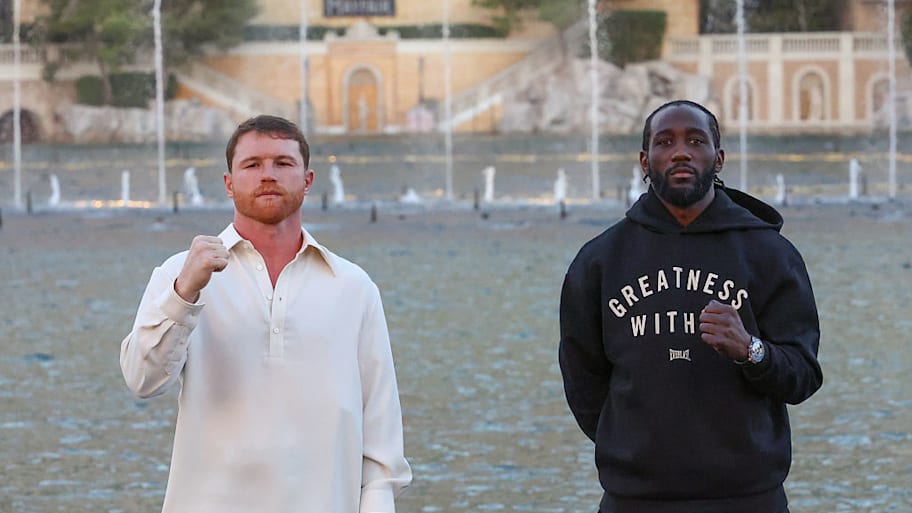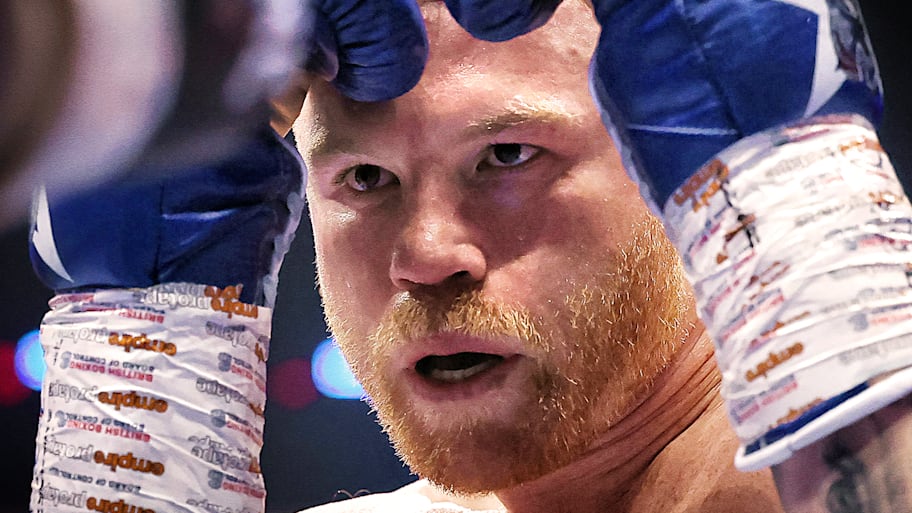
RENO, Nev. – Last month, inside a UFC gym tucked in a strip mall in western Nevada, Saul “Canelo” Álvarez patiently went through the motions. Not in the ring—where Álvarez has built an enviable career, racking up 63 wins and championships in four divisions—but outside it. It’s media day here and a dozen or so outlets are waiting for their 10 minutes with boxing’s biggest star.
For more than an hour, Álvarez shuffles between interviews. The questions quickly become repetitive. How do you feel about fighting Terence Crawford? On Saturday, Canelo will defend his titles against Crawford, the former welterweight king who will leap up two weight classes for the opportunity. For Crawford, it’s the chance to cement his legacy as a three-time undisputed champion. For Álvarez, it’s his first nine-figure payday—$125 million, according to multiple sources with knowledge of the contract.
Another: Do you still feel like you are at your best? Álvarez has been a pro for nearly two decades. He has collected belts between 154 and 175 pounds. In that time he has engaged in many memorable fights, from a decision loss to Floyd Mayweather Jr. to a knockout win over Sergey Kovalev to his trilogy with Gennadiy Golovkin. He hasn’t been considered a top pound-for-pound fighter since 2022, when Dmitry Bivol stunned him in a light heavyweight title defense. He still thinks he is.
Eventually, Álvarez makes his way to me. I’ve covered him since 2010, when he first appeared on a major U.S. show, on the undercard of Mayweather’s fight against Shane Mosley. I’ve watched him develop from popular prospect to big attraction to the best fighter in the game. I’ve seen him overcome adversity (a largely noncompetitive fight against Mayweather), controversy (an ugly split from Oscar De La Hoya and Golden Boy Promotions) and, at least to this point, Father Time. Even if Álvarez isn’t the best fighter in boxing, at 35 he remains among its top 10.
Settling onto a couple of stools, I go to the familiar well. On Crawford, who Álvarez showed little interest in facing as recently as a year ago, he now sees an opportunity to make another mega fight. “I knew it would happen one day,” says Álvarez. “It was going to be a big fight because always, with Mexican and an American fighter, it is always a big, big fight.” The presence of Turki Alalshikh, the Saudi official bankrolling the event, didn’t hurt, either.
On his place among boxing’s best, Álvarez is unwavering. “I always feel I’m the best, no matter what the people say.” Yes, Álvarez lost to Bivol. No, he has not knocked out an opponent since 2021, since he stopped Caleb Plant to collect the final belt at 168 pounds. But he has won six fights since then, and he has not been threatened in any of them. If there’s erosion in his skills, Álvarez says, it isn’t much.
There’s another topic, one I’m interested in exploring: How does Álvarez stay motivated? Marvin Hagler, the ex-middleweight champion, once said, “It’s tough to get out of bed to do roadwork at 5 a.m. when you’ve been sleeping in silk pajamas.” Translation: training isn’t easy when you don’t have to.
Canelo doesn’t have to. He ranked 22nd on Forbes’s most recent list of highest paid athletes, with a net worth of $275 million. He’s a business tycoon, owning all or part of everything from gas stations to convenience stores, a fitness app (I CAN) to a clothing line. In 2022, Canelo launched VMC—short for “Viva México, Cabrones,” a favored tag line in postfight interviews—a tequila-based cocktail with distribution across North America. He’s part of a group opening a Ritz-Carlton in Puerto Vallarta. Generations of Álvarez’s family will never want for money.
So why do it? Mid-30’s is when many fighters’ careers tend to flicker. The pace slows, the passion fades, the desire to go through grueling, 10-week training camps vanishes. De La Hoya was 36 when he quit boxing. Andre Ward walked away at 33. Álvarez, though, doesn’t see his exit as imminent. He enjoys boxing. He loves training. On his T-shirt is emblazoned his slogan: No Boxing, No Life. It was true in 2005, when he made his pro debut. It remains true today, as he prepares for what will be the biggest event of his career.

“I love boxing,” says Álvarez. “I love everything about boxing. I love my whole routine in training camp and I never thought, ‘I don’t need to be here.’ I want to be here.”
In 2010, Álvarez faced Carlos Baldomir, an ex-welterweight titleholder. It was a relatively low-level event, two fights down on the undercard of a junior middleweight fight between Shane Mosley and Sergio Mora. Richard Schaefer remembers it well. How a sweeping left hook sent the iron chinned Baldomir face first to the canvas. How the pro-Mexican crowd responded to him. “We knew then,” says Schaefer, “that we had a superstar.”
There were signs before. For years, Schaefer had a friendly relationship with Chepo Reynoso, a veteran trainer in Jalisco, a western Mexican state that touches the Pacific. Golden Boy promoted two of Reynoso’s top fighters, Óscar Larios and Javier Jáuregui. Whenever Schaefer spoke to Reynoso, he insisted on talking about another fighter: Álvarez.
The youngest of eight children, Álvarez’s boxing education began on the streets, in Jalisco. His red hair and light complexion made him a target for bullies. Until, that is, Álvarez began to fight back. His eldest brother, Rigoberto, steered him toward a local boxing gym where he met Chepo and his son, Eddy, famed trainers who had guided Mexican fighters to various levels of success.
In Mexico, the Reynosos guided Canelo to early success. He racked up wins. He’d fight six, sometimes seven times per year. He won 30 fights by the time he was 19. More, if you believe his team, who swears there were another 10 that, because of some shaky record-keeping in Mexico, weren’t counted on his official ledger. After each brilliant performance, Chepo would ring up Schaefer. “He kept telling me, ‘This is the guy,’ ” says Schaefer. “He called him his masterpiece.”
Schaefer was impressed by the talent. He was more wowed by the following. Álvarez had the support of Televisa, the Mexican broadcast giant that reportedly reached 95% of Mexican homes. It made Canelo omnipresent in Mexico. He was on talk shows, morning shows, game shows. Televisa presented Álvarez as a Mexican-born De La Hoya. Fans flocked to him. In the early 2000’s, Golden Boy co-promoted one of his fights. It drew a crowd of 6,000. According to De La Hoya, another 1,000 were outside hoping to get in.

Schaefer smiles at those memories, and all that came after. Golden Boy formally signed Álvarez in 2010 and put him on a path to becoming the biggest star in boxing. In ‘13, he fought Mayweather, losing a decision to the then pound-for-pound king. A year later, he defeated Erislandy Lara, a win that established Álvarez as a true top talent. From there it was Miguel Cotto, Amir Khan and Golovkin. Daniel Jacobs, Kovalev and Callum Smith. Small arenas, big arenas, stadiums. When Mayweather officially retired in ‘17, Alvarez became boxing’s biggest star.
Last December, Schaefer got a call from Álvarez. The two parted ways professionally in 2014, when Schaefer split from Golden Boy over differences with De La Hoya. They had remained friendly, but Álvarez was calling for professional reasons. Álvarez had built a vast business empire. And he needed Schaefer’s help running it.
Álvarez’s portfolio, says Schaefer, is vast. VMC, his tequila drink, is on track to sell more than 2 million cases and is valued at more than $200 million. His convenience store chains are successful, and there are plans to expand them into the U.S. “He gets approached weekly by people that want to be part of the Canelo brand,” says Schaefer. There have been discussions about outside the ring deals with Alalshikh, who Álvarez cut a four-fight deal with earlier this year.
A year earlier, that deal seemed unlikely. Alalshikh bulldozed into boxing in 2023, spending hundreds of millions on marquee fights. Early on, the relationship with Álvarez was contentious. The two often sniped at each other in interviews and social media. When Álvarez signed to fight Edgar Berlanga last September, Alalshikh, who sponsored the UFC show on the same night, said the MMA card would “eat” Álvarez’s.
Last January, shortly after reaching out, Álvarez asked Schaefer to travel with him to London, where he was to attend an awards show thrown by Ring Magazine, the iconic boxing publication Alalshikh recently bought. That trip, says Schefer, was “a peacemaking effort.” Over two days, Alalshikh and Canelo buried the hatchet, resulting in the historic deal that will see Álvarez have the most lucrative year of his career.
All the runarounds have often made Schaefer wonder why Álvarez continues on. It’s a question he posed to him this week, when Álvarez was finishing a training session at a local Las Vegas gym. Álvarez’s answer to him was the same one he gave me weeks earlier. “He genuinely still loves it,” says Schaefer. “And he said, ‘Look, I chose to do this. I don’t have to, but I do it because I love it.’ ”
There could be another reason. Among most, Canelo’s boxing legacy is secure. He will be on a short list for the greatest fighters of his generation and an even shorter list of boxing’s most bankable stars. Eventually, he will walk into the boxing Hall of Fame on the first ballot. There are areas to nitpick—his delay in fighting Golovkin, his decision not to fight David Benavidez—but by any measure, his résumé is one of an all-time great.
“I think I accomplished everything in boxing already,” says David Benavidez. “What else can I accomplish, right? I accomplished everything. No. 1 fighter, two-time [undisputed], four weight class [champion]. I do everything.”

In Mexico, there is one true great: Julio César Chávez. For decades, Chávez defined Mexican boxing. The aggression. The swagger. The refusal to back down. Chávez’s peak—late 1980’s, early ‘90’s, give or take—came during a rise in Mexican migration to the U.S. That made Chávez an idol to Mexicans living in the country and something of a folk hero to those outside it. To other fighters, it cast a long shadow.
Álvarez insists he isn’t chasing Chávez. He’s comfortable with his own accomplishments. He got into boxing to become a world champion. He has achieved far more than that. He was too young to remember the best of Chávez, the blood-and-guts warrior who racked up titles across three weight divisions, who spent years atop pound-for-pound lists, who connected so closely with the Mexican fans he once drew 136,000 for a title defense against Greg Haugen and rewarded them by administering to Haugen a savage beating. But he believes he has carved out a legacy of his own.
“I want to make my own history,” Canelo told me recently. “I don’t want to be equal to anyone or be like anyone. I respect everyone. But when they talk about boxing, they always remember Canelo.”
On Saturday, Álvarez will take another step towards that. A fight with Crawford is the most marketable fight in boxing. Crawford, a two-time undisputed champion, after just one fight at 154 pounds, will attempt to do the improbable and become undisputed at 168 pounds. Crawford has dismissed the size difference and insisted that, come fight night, he will take the fight to Canelo.
“I’ve been doubted my whole career, my whole life,” said Crawford. “‘I’ve been told I would never be where I am at now. I was told I need to get another job because I wasn’t going to be world champion. So many things that I have been told in my life where I’ve said, ‘O.K., just watch me do it.’ With my belief in myself, I don’t care what nobody else say.”
It’s an attitude Canelo hopes Crawford to take into the ring. Álvarez has faced credible fighters in recent years. But few were willing to engage with him. His last opponent, William Scull, ran for the better part of 12 rounds. Asked if he would run, Crawford said, “I’m going to run upside his head.”
Álvarez smiles at Crawford’s rhetoric. “I hope it’s true,” he says. For Canelo, this fight is his showcase. More than 60,000 fans are expected to fill Allegiant Stadium. The fight will be streamed on Netflix, giving him the kind of reach he has never had. “The magnitude of this fight is different,” says Álvarez. “It’s going to be a good fight. I will give the people a good performance.”
And another reason to remember Canelo.
More Boxing on Sports Illustrated
This article was originally published on www.si.com as How Canelo Alvarez Stays Motivated From Atop Boxing’s Throne.
